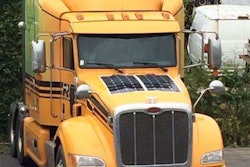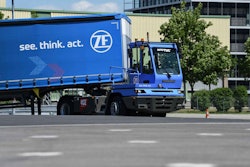The electrification of trucking may “the next big thing” but the electrification of the truck itself isn’t an entirely new concept. The differentiator of the two discussions is a big one.
The electrification of trucking centers on removing a traditional driveline and replacing it with a number of electric drive motors. On-board electrification is just removing mechanically driven components that rely on power from the engine and replacing them with electric ones.
The more components you can power electrically the more horsepower to can put to the driveshaft, thereby increasing the truck’s overall diesel fuel efficiency by drying up parasitic losses. Battery-powered HVAC and hotel load systems were among the first examples of this shift and more are on the horizon.
Replacing hydraulic steering with a computer-controlled electric motor, for example – a technology that already exists – negates the need for a mechanically driven power steering pump. It could also remove the steering gear, Pitman arm and drag link, reducing weight while offering more refined, precise and less fatiguing steering control.
You can also electrify components that don’t require direct contact with the engine to make them better. I spent the better part of a week in June with component manufacturer ZF at their Friedrichshafen, Germany, headquarters where among the many things they showcased was an electrically assisted truck cab leveling and shock dampening system.
A standard system uses air and springs to prevent shock from the highway from rocking the driver, but an electrically assisted version could use data from the truck’s computer to compensate for road input before it ever makes its way to the cab. That translates to an exponentially smoother ride, which will become increasingly important as the truck transitions itself through the levels of autonomy and ultimately becomes the driver’s mobile office.
A traditional 12-volt power system can neither support nor facilitate a wide adaption of formerly-mechanically-driven-but-now-electrically-powered components but the conversation about a 48-volt power system gets louder every day. I don’t think a leap like that is going to be quick or easy, but I think it is going to be critical in the years ahead.
Another benefit of going some degree of electric is that the power supply is practically infinite and free if you don’t have to plug in.
That’s an admittedly liberal usage of “free,” but it doesn’t rain diesel fuel. If you’re willing to pony up the dollars for solar panels, the sun will dump free energy back into your batteries at levels that can feel close enough to zero-cost. Solar has found its place on tractors mostly as an anti-idle and fuel economy play by supporting battery-powered HVAC and hotel loads, but the North American Council for Freight Efficiency found in a recent report that solar capabilities also help reduce downtime associated with dead batteries.
Segments that frequently start and stop over short distances were among the earliest adopters of solar power, using the sun to charge liftgate and reefer batteries since the trucks often didn’t travel long enough distances between stops for the alternator to do it. Small solar panels are also useful to power trailer telematics since their power draw is fairly minimal.
Solar panels can be easily mounted on the roof of a trailer because it’s long and flat. On the tractor side, that can be problematic. There are several thin and flexible panels on the market that are designed to mount on a tractor’s roof fairing but real estate is a premium on the truck when compared to the 53-feet of available flat space on a trailer.
An electric truck is going to make a lot of sense for a few segments – like regional and final mile applications – fairly soon. However, a strong business case for long-haul has not yet fully materialized. Hybridization – the electrification of certain components that can squeeze a few more MPGs from the fuel tank, and supplementing their power draw with the integration of solar energy – is a viable bridge to full electrification in the meantime.











